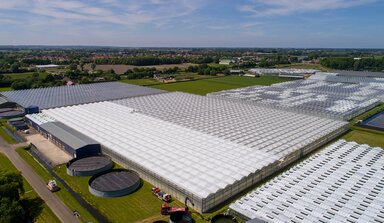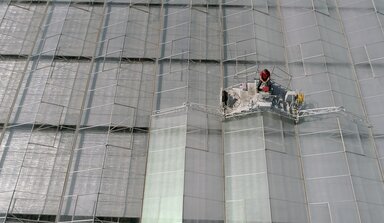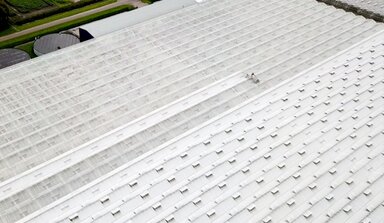Diffuse light for Gerbera
Gerbera is a light sensitive crop that benefits from high sums of light. However, during the summer months, too much light can damage both growth and quality. Therefore gerbera crops always need to be protected. This can be achieved by using a coating, screen or a combination of both. In practice, we see that the combination of a fabric screen with a coating leads to the best results. Also, over the last few years we have seen a shift towards diffuse shading products.
Diffuse light
When light is diffuse a plant can often process a higher light intensity without any damage occurring. Diffuse light is scattered light. On clear days the light is direct, on cloudy days it is mostly diffuse. The amount of light diffusion is expressed as the haze factor. Clear glass has a haze factor of 0%, diffuse glass has a haze factor of 20-80% depending on the type of glass. Diffuse coatings produce a haze of 70-80% depending on the type of coating chosen and the concentration.
A few advantages of diffuse light are:
- Better horizontal light distribution
- Light penetrates more deeply into the crop
- Higher net photosynthesis
- Lower plant temperature which improves flower initiation
- Steadier climate which reduces the need to use screens
- Better flower quality
- More vigorous crop
Coating
Gerbera benefits from lots of light so this needs to be taken into account when using a coating on the roof and therefore it is important to choose the right one. In practise several types of coatings are used: ReduHeat for heat reflection; ReduFuse IR for diffuse light and heat reflection; and ReduSol to reflect light and heat. The coating that best suits your situation is among other things dependent on the type of greenhouse, type of screen and crop variety. In practice, we see that ReduFuse IR is chosen more and more often for its diffuse and heat reflecting properties and also because it has high light transmittance.
When to apply which coating for a gerbera crop?
The greenhouse temperature remains lower when the roof is coated. ReduSol gives the best heat protection, but at the same time also shades out a lot of grow-light. When an extremely warm period is expected, or in more southern countries, ReduSol is sometimes applied as a second layer. Then a thin layer is sprayed over ReduHeat or ReduFuse IR during the summer months. ReduHeat provides good protection against infrared light and at the same time allows high transmission of growth light. ReduFuse IR has the additional ability to make the light diffuse. Then the crop temperature will generally be lower than when using ReduHeat, despite it reflecting less infrared. This lower crop temperature is mainly due to the higher diffusion capability of ReduFuse IR compared with ReduHeat. This is especially beneficial for producing more growth in generative crops.
However, the type of coating that best suits your situation is very dependent on the circumstances, such as type of greenhouse, type of screen(s) and crop variety. For tailor-made advice please contact Mardenkro or your crop advisor.
Why use a coating if I have a screen?
In many cases one or more screens are already present in the greenhouse. If a black-out screen is the only one available, advantages can quickly be gained by applying a coating to the roof. In more modern greenhouses, in addition to the blackout cloth, a second screen is often present with a diffuse and sometimes open structure. Of course, this type of screen can reflect both light and heat. A disadvantage however, is the limited amount of air exchange and, when the cloth has a closed structure, the fact that the screen cannot be fully closed because gaps will be required. Due to the lower air exchange the greenhouse temperature can become too high. This happens less when using a coating and it is possible to use the available ventilation capacity for longer. The screen can then be used to flatten out the light and temperature peaks over the course of a day.
When to apply
ReduHeat and ReduFuse IR can often be applied fairly early in the spring. In April the radiation can rise a lot and a young crop can quickly find itself in a stressful situation. Experience has taught that, for a sufficiently generative gerbera crop, applying the coating in time only leads to advantages. The timing of the application is mostly dependent on the weather forecast and the crop conditions. The time to apply a coating should be a bit earlier with a generatively growing crop than with a very vigorous or vegetative crop.

Figure 1: Infra red photos of a gerbera crop under diffuse light (left) and direct light (right).
The crop temperature on the right is clearly higher (more orange and yellow).


